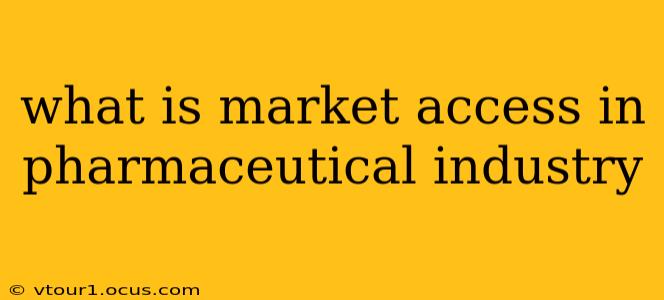Market access in the pharmaceutical industry refers to the complex process of ensuring that patients have timely and affordable access to needed medicines. It's much more than simply getting a drug approved by regulatory bodies like the FDA; it involves navigating a multifaceted landscape of regulations, reimbursement policies, and healthcare systems to make sure the drug reaches the intended patient population. Think of it as the bridge between drug development and patient care.
This process is crucial because even the most innovative drug is useless if it can't reach the patients who need it. The cost, availability, and reimbursement of a medicine directly impact its accessibility and ultimately, its effectiveness in improving public health.
Why is Market Access Important?
The pharmaceutical industry faces significant challenges in getting new drugs to market. High development costs, stringent regulatory hurdles, and the need to demonstrate clinical value are just some of the factors that contribute to the complexity. Without effective market access strategies, pharmaceutical companies risk:
- Wasted R&D investment: Years and billions of dollars are invested in developing new drugs. Without a clear path to market access, this investment can be lost.
- Limited patient benefit: Innovative treatments remain unavailable to those who need them most, hindering advancements in healthcare.
- Reduced return on investment: Companies may not recoup their investment if they fail to secure market access, impacting future drug development.
What are the Key Components of Market Access?
Market access is a multifaceted process, encompassing various key areas:
1. Regulatory Approvals:
This is the initial hurdle, involving the submission of comprehensive data to regulatory agencies (like the FDA in the US or EMA in Europe) to demonstrate the drug's safety and efficacy. Successful navigation of this phase is paramount for subsequent market access activities.
2. Pricing and Reimbursement:
This involves negotiating prices with government payers (e.g., Medicare, Medicaid) and private insurance companies. The price needs to be both commercially viable for the pharmaceutical company and affordable for patients and healthcare systems. This often involves demonstrating the clinical and economic value of the drug, often through Health Technology Assessments (HTAs).
3. Health Technology Assessments (HTAs):
HTAs are systematic evaluations of the medical, social, and economic impacts of a healthcare intervention, including pharmaceuticals. They help payers decide whether a drug offers sufficient value to justify its cost, playing a significant role in reimbursement decisions.
4. Distribution and Supply Chain:
Efficient and reliable distribution networks are essential to ensure that drugs reach patients in a timely manner. This includes logistical challenges such as storage, transportation, and inventory management.
5. Patient Access Programs:
Many pharmaceutical companies offer patient assistance programs to help patients afford their medications, particularly those with high out-of-pocket costs or limited insurance coverage. These programs can be crucial in ensuring equitable access to essential treatments.
6. Advocacy and Stakeholder Engagement:
Building relationships with key stakeholders, including physicians, patient advocacy groups, and policymakers, is essential for navigating the complexities of market access. Advocacy efforts can help to shape policy and raise awareness about the importance of access to specific treatments.
How Does Market Access Differ Across Countries?
Market access strategies vary significantly depending on the healthcare system in place. Countries with universal healthcare systems (like Canada or the UK) often have centralized reimbursement processes, while those with more market-based systems (like the US) have more decentralized and complex pathways. This necessitates tailoring strategies to each specific market.
What are the Future Trends in Pharmaceutical Market Access?
The future of pharmaceutical market access will likely be shaped by:
- Value-based pricing: A shift towards models that focus on the clinical and economic value of a drug rather than simply its cost.
- Real-world evidence: Increased reliance on data from real-world settings to demonstrate a drug's effectiveness and cost-effectiveness.
- Digital health technologies: Integration of digital tools to improve patient engagement and track treatment outcomes.
- Personalized medicine: Tailoring treatment to individual patients, impacting access strategies due to the potential for higher costs and individualized reimbursement negotiations.
Understanding market access is crucial for both pharmaceutical companies and healthcare systems to ensure patients have access to the medications they need. The complexity of the process requires a collaborative approach among all stakeholders involved.
